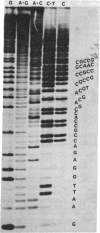Abstract
A cDNA made to antifreeze protein mRNA of the winter flounder was cloned in the plasmid pBR322 and its sequence was determined by the method of Maxam and Gilbert. Its sequence codes for a precursor protein that is 82 amino acids in length. This precursor has both a signal polypeptide and a prosequence before the mature protein of 38 amino acid residues. The mature protein matches in composition one of the alanine-rich serum antifreeze proteins that was purified by ion-exchange and reverse-phase chromatography. The composition of the pro- sequence is similar to that of the native protein except that it contains five prolines. The mature protein, but not the pro- sequence, contains three of the 11-residue repeats previously observed [Lin, Y. & Gross, J. K. (1981) Proc. Natl. Acad. Sci. USA 78, 2825-2829] in two other antifreeze protein components.
Full text
PDF




Images in this article
Selected References
These references are in PubMed. This may not be the complete list of references from this article.
- Ananthanarayanan V. S., Hew C. L. Structural studies on the freezing-point-depressing protein of the winter flounder Pseudopleuronectes americanus. Biochem Biophys Res Commun. 1977 Jan 24;74(2):685–689. doi: 10.1016/0006-291x(77)90357-6. [DOI] [PubMed] [Google Scholar]
- Chou P. Y., Fasman G. D. Prediction of protein conformation. Biochemistry. 1974 Jan 15;13(2):222–245. doi: 10.1021/bi00699a002. [DOI] [PubMed] [Google Scholar]
- Davies P. L., Hew C. L. Isolation and characterization of the antifreeze protein messenger RNA from the winter flounder. J Biol Chem. 1980 Sep 25;255(18):8729–8734. [PubMed] [Google Scholar]
- Devries A. L., Lin Y. Structure of a peptide antifreeze and mechanism of adsorption to ice. Biochim Biophys Acta. 1977 Dec 20;495(2):388–392. doi: 10.1016/0005-2795(77)90395-6. [DOI] [PubMed] [Google Scholar]
- Fletcher G. L. Circannual cycles of blood plasma freezing point and Na+ and Ci- concentrations in Newfoundland winter flounder (Pseudopleuronectes americanus): correlation with water temperature and photoperiod. Can J Zool. 1977 May;55(5):789–795. doi: 10.1139/z77-103. [DOI] [PubMed] [Google Scholar]
- Hew C. L., Liunardo N., Fletcher G. L. In vivo biosynthesis of the antifreeze protein in the winter flounder - evidence for a larger precursor. Biochem Biophys Res Commun. 1978 Nov 14;85(1):421–427. doi: 10.1016/s0006-291x(78)80059-x. [DOI] [PubMed] [Google Scholar]
- Hew C. L., Yip C. The synthesis of freezing-point-depressing protein of the winter flounder Pseudopleuronectus americanus in Xenopus laevis oocytes. Biochem Biophys Res Commun. 1976 Aug 9;71(3):845–850. doi: 10.1016/0006-291x(76)90908-6. [DOI] [PubMed] [Google Scholar]
- Lederberg E. M., Cohen S. N. Transformation of Salmonella typhimurium by plasmid deoxyribonucleic acid. J Bacteriol. 1974 Sep;119(3):1072–1074. doi: 10.1128/jb.119.3.1072-1074.1974. [DOI] [PMC free article] [PubMed] [Google Scholar]
- Lin Y., Gross J. K. Molecular cloning and characterization of winter flounder antifreeze cDNA. Proc Natl Acad Sci U S A. 1981 May;78(5):2825–2829. doi: 10.1073/pnas.78.5.2825. [DOI] [PMC free article] [PubMed] [Google Scholar]
- Maxam A. M., Gilbert W. Sequencing end-labeled DNA with base-specific chemical cleavages. Methods Enzymol. 1980;65(1):499–560. doi: 10.1016/s0076-6879(80)65059-9. [DOI] [PubMed] [Google Scholar]
- Pelham H. R., Jackson R. J. An efficient mRNA-dependent translation system from reticulocyte lysates. Eur J Biochem. 1976 Aug 1;67(1):247–256. doi: 10.1111/j.1432-1033.1976.tb10656.x. [DOI] [PubMed] [Google Scholar]
- Raymond J. A., Radding W., DeVries A. L. Circular dichroism of protein and glycoprotein fish antifreezes. Biopolymers. 1977 Nov;16(11):2575–2578. doi: 10.1002/bip.1977.360161119. [DOI] [PubMed] [Google Scholar]
- Seidah N. G., Routhier R., Benjannet S., Larivière N., Gossard F., Chrétien M. Reversed-phase high-performance liquid chromatographic purification and characterization of the adrenocorticotropin/lipotropin precursor and its fragments. J Chromatogr. 1980 May 23;193(2):291–299. doi: 10.1016/s0021-9673(00)81498-3. [DOI] [PubMed] [Google Scholar]
- Thayer R. E. An improved method for detecting foreign DNA in plasmids of Escherichia coli. Anal Biochem. 1979 Sep 15;98(1):60–63. doi: 10.1016/0003-2697(79)90705-x. [DOI] [PubMed] [Google Scholar]
- Thibodeau S. N., Palmiter R. D., Walsh K. A. Precursor of egg white ovomucoid. Amino acid sequence of an NH2-terminal extension. J Biol Chem. 1978 Dec 25;253(24):9018–9023. [PubMed] [Google Scholar]
- Wickens M. P., Buell G. N., Schimke R. T. Synthesis of double-stranded DNA complementary to lysozyme, ovomucoid, and ovalbumin mRNAs. Optimization for full length second strand synthesis by Escherichia coli DNA polymerase I. J Biol Chem. 1978 Apr 10;253(7):2483–2495. [PubMed] [Google Scholar]



